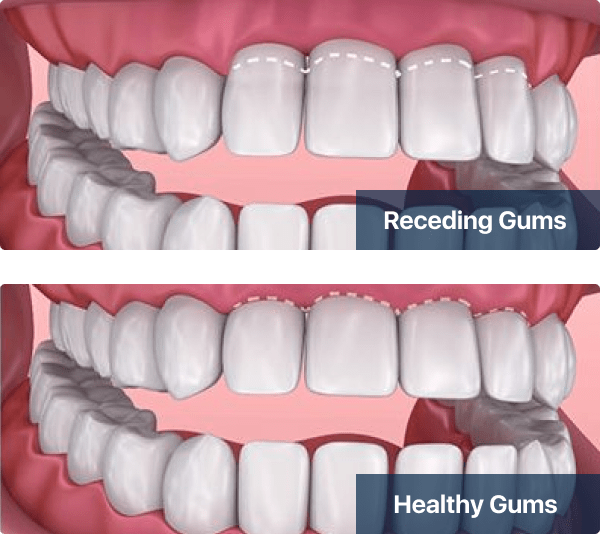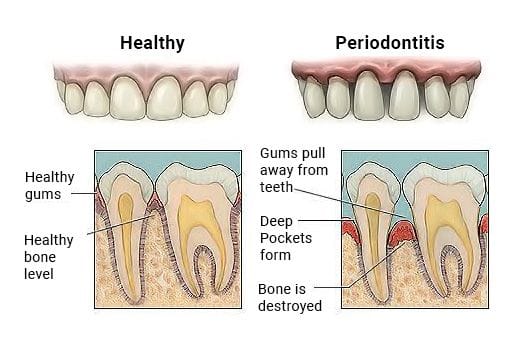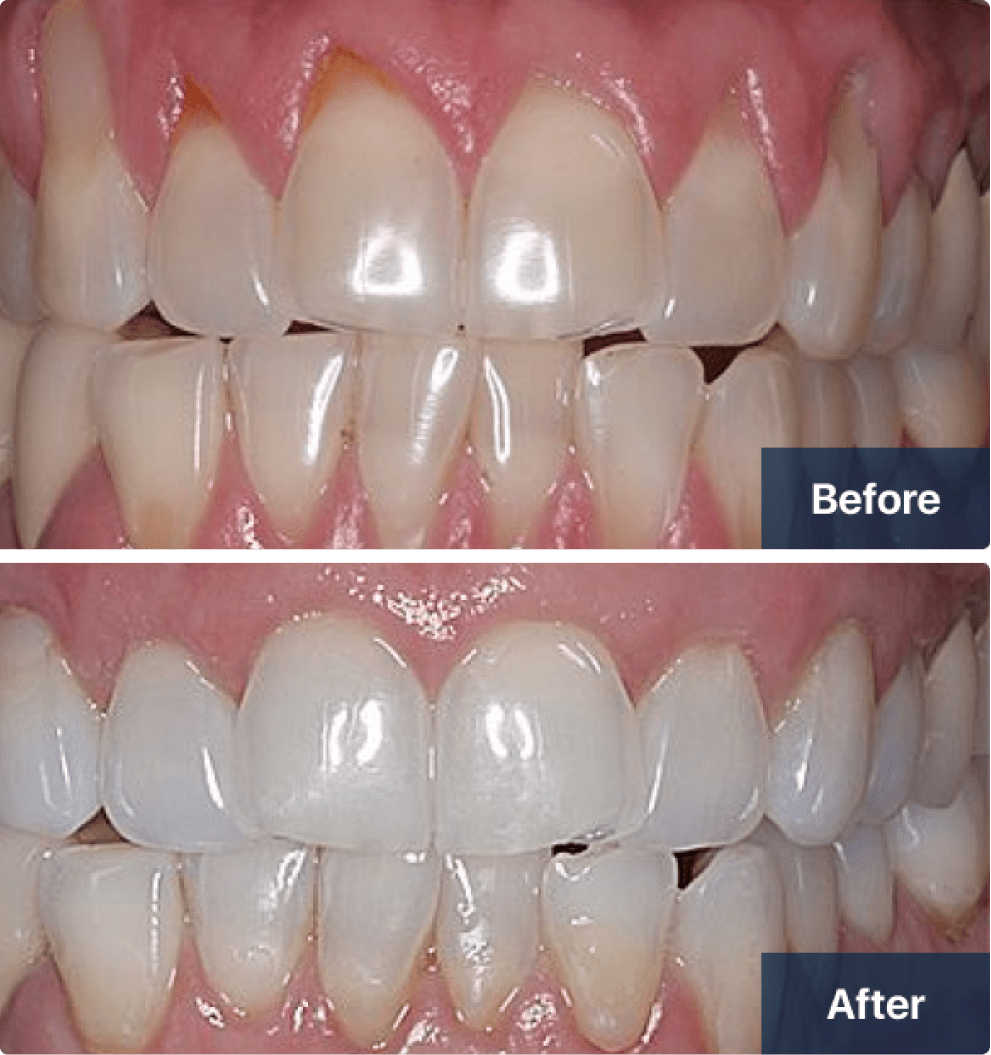Gum recession
These are both common signs of gum recession, a condition that affects many adults in the US. It occurs when the gums become less snugly attached to your teeth and begin to recede. Eventually, this recession will expose the tooth roots. Your teeth may look yellow around their margins. This is due to the cementum being exposed to the tooth roots.
It can look quite unsightly, but will also increase the risk of tooth decay in the tooth root area as cementum isn’t as hard and durable as tooth enamel. Additionally, by this point,you may begin to feel other signs of discomfort such as increased tooth sensitivity to hot and cold.

What Causes Gum Recession?
Gum recession may be caused if you brush your teeth too hard. This wears away the tissue. It may happen if you are using a toothbrush that has very hard bristles or are simply applying too much pressure during brushing.
Some people are naturally more prone to gum recession because their tissue is thinner than normal. This comes down to genetics. Gum recession can also occur as a side-effect of aging, hence the expression “long in the tooth.” However, a far more common reason for gum recession is gum disease.
Why Do We Need Healthy Gums?
Healthy gums are designed to form a tight seal around your teeth. Healthy gums are firmly attached to your teeth through connective tissues and through the underlying jawbone.
Strong and healthy gums help to prevent bacteria in the mouth from getting into the bone and tissues surrounding your teeth. They also help cushion and protect your teeth during high impact actions such as eating, chewing, and tooth brushing.
Your gums are attached to your teeth through collagen fibers. These fibers can deteriorate due to trauma and inflammation. Deterioration leads to gum recession. As the gums begin to recede, the difference between the color of the tooth root and your actual tooth will become more apparent, resulting in a less than aesthetic smile.
Additionally, the gums are designed to fit snugly in the contact areas in between your teeth. As they recede this can create unsightly spaces that will look like black triangles. These spaces easily trap food and plaque.
Identifying the Reason Why Your Gums Are Receding
 If you have noticed any signs of gum recession it is important to take action. Visit your dentist or preferably- a periodontist. A periodontist is a dentist who specializes in treating problems with the gum. A periodontist has undergone several years of additional training after dental school.
If you have noticed any signs of gum recession it is important to take action. Visit your dentist or preferably- a periodontist. A periodontist is a dentist who specializes in treating problems with the gum. A periodontist has undergone several years of additional training after dental school.
They will be able to thoroughly examine your gum tissue and identify the exact reason for your gum recession. They can also assess the extent of the damage, including whether the recession has affected the underlying structures such as the connective tissues, teeth, and bones. Once they have all this information, they can provide you with a suitable treatment plan to rectify this situation.
Often recession is caused by gum disease or to give it its correct name, periodontal disease. This is an extremely serious condition that can eventually result in tooth loss. It will begin to eat away the bone surrounding your teeth. It is a bacterial infection that normally results due to poor oral hygiene.
Why Poor Oral Hygiene Causes Periodontal Disease
Dentists recommend brushing at least twice a day and flossing at least once a day. However, sometimes the temptation to skip brushing and particularly to skip flossing can soon become a habit. This allows harmful bacteria to build up over the surfaces of your teeth and gums. These bacteria are contained in a sticky plaque biofilm.
If it’s been a while since you last brushed your teeth, try running your tongue over your tooth surfaces. You will feel this film. The bacteria within plaque produce toxins that promote inflammation and infection.
Failing to regularly remove plaque allows it to harden into calculus. Calculus is a mineralized deposit that is extremely hard. Brushing does not remove it. This can happen within just a couple of days. You may even be able to see calculus build up on your teeth around the margins where your gums meet your teeth. Calculus can look almost yellowish in appearance and can only be removed by having your teeth professionally cleaned either by your dentist or periodontist.
Treating Periodontal Disease
Treatments for gum disease
There are several non-surgical and surgical treatments for gum disease. The method depends on its progression and the destruction you already have. Your periodontist will be able to advise you about which treatments are most suitable for you.
The most common treatment is called scaling and root planing which deep cleans the gums. It is a scaling and polishing treatment that is normally carried out during a hygiene treatment. It will clean or scale any exposed tooth roots as this is often where calculus tends to build up. Scaling and root planing treatments may be recommended as part of an ongoing maintenance plan to prevent periodontal disease from recurring
Advanced treatments
More advanced treatments will surgically remove the bacteria causing the infection. These treatments can also help to rebuild tissues destroyed by periodontal disease. Some of these treatments are extremely sophisticated, using advanced bone grafting techniques and gum grafting procedures to help restore lost tissues. These surgical treatments not only help to replace lost bone and gum but will also protect the teeth and improve the overall aesthetic appearance of your smile.
Sometimes the periodontal disease is too far advanced to save teeth. Dental implants can be used to restore them once your periodontist has brought the disease under control.

Regular dental
Regular dental checkups help reduce the likelihood of developing periodontal disease, particularly when combined with regular dental cleanings. If you haven’t visited a dentist for a while but are concerned your teeth look longer than you remember, or if you have noticed your gums bleed frequently when you brush or floss, it’s time to schedule an appointment.
